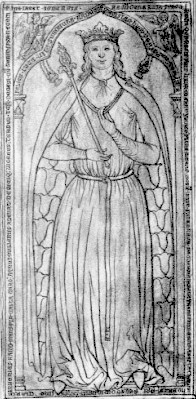Ingeborg of Denmark
Ingeborg of Denmark (also Ingeborg of France , Ingeburge or Isambour , * around 1175 , † July 29, 1236 in Corbeil ) was a Danish princess and queen of France by marriage .
Life
Ingeborg of Denmark was the daughter of the Danish king Waldemar I and his wife Sophia of Minsk . The later Danish kings Canute VI. and Waldemar II were her brothers.
Her birth year, which was assumed to be around 1175, suggests that she was the seven-year-old daughter of King Waldemar, whose name has not been passed down, who lived with the fourteen-year-old Duke Friedrich VI in 1181 . von Schwaben , the third son of Emperor Friedrich I Barbarossa , was betrothed. After Waldemar's heir to the throne, King Canute VI. did not adhere to the agreed dowry payment, Barbarossa sent his son's bride, who had been living in Germany for five years at that time, back to Denmark unaffected (Latin: intacta ) in 1187 .
In 1193 the French King Philip II August succeeded in taking King Canute VI. of Denmark to win an alliance against the Angevin Empire . Therefore, Knut's sister Ingeborg should be married to Philipp to strengthen the covenant. On August 15, 1193, the wedding took place in the Cathedral of Amiens . After the wedding night, however, the French king refused to continue the marriage and showed a negative attitude towards his wife. In her presence he suddenly felt an inexplicable tremor. The reason for his puzzling behavior could not be deciphered until today. In French chronicles, the Danish princess is described as a beautiful woman who was also a good surrogate mother to her stepson Ludwig.
Philip II August expelled his wife on November 5, 1193 in Compiègne . Ingeborg rejected the idea of divorce and insisted on the rights of a queen of France. The French king called for annulment of the marriage and led as an argument the close relationship between Ingeborg and his first wife Isabella of Hainault at († 1190). The marriage was finally divorced by French prelates and on June 1, 1196, Philip married Agnes-Maria von Andechs-Meranien . Ingeborg was imprisoned by Philipp first in the Abbey of Cysoing near Tournai and later in the tower of the castle Étampes , while his new wife resided in the royal palace in Paris . However, the divorce was not confirmed by the Pope and the Curia . The French king was therefore canonically married to two women from 1196 to 1200 and thus lived in bigamy .
Years of disputes about the dissolution of the marriage followed after Ingeborg turned to Pope Coelestin III. had turned to the excommunication of Philip II by the subsequent Pope Innocent III. led. Philipp was forced to part with Agnes von Meran again, whom he rejected on September 7, 1200 in order to break the ban. At the end of the year he had to bring Ingeborg back to the French court. Agnes retired to Poissy Castle and died in July 1201 after the birth of her son Tristan. Even after Agnes' death, Philipp was not ready to give up his plans for divorce. In 1208 he asked the Pope for a divorce. He locked Ingeborg of Denmark in different dungeons and tried to get her to dissolve the marriage. In 1212, the Danish princess confirmed the consummation of the marriage under oath and thus stopped the divorce process. Philip had to free Ingeborg from captivity in 1213 and recognize her as the rightful queen. However, the spouses lived separately until Philip's death in 1223. In his will, Philipp called Ingeborg “ carissima uxor ” (most expensive wife). As a widow, she stayed mostly in Orléans and Corbeil . She finally died on June 29, 1236 in Corbeil and was buried in Saint-Jean-sur-l'Isle near Corbeil; the second step of her funeral in Saint-Denis had her Saint Louis refused.
The magnificent Ingeborg Psalter has been preserved from the possession of Ingeborg of Denmark .
Web links
- Entry at www.mittelalter-genealogie.de
- Ingeborg von Denmark on danmarkshistorien.dk (Danish)
Individual evidence
- ^ Tobias Weller: The marriage policy of the German high nobility in the 12th century. Cologne 2004, pp. 130-136.
| predecessor | Office | Successor |
|---|---|---|
| Isabella of Hainaut |
Queen of France 1193–1196 |
Agnes-Maria of Andechs-Meranien |
| personal data | |
|---|---|
| SURNAME | Ingeborg of Denmark |
| ALTERNATIVE NAMES | Ingeborg of France; Isambour de Denmark; Ingeburge de Denmark |
| BRIEF DESCRIPTION | Danish princess and queen of France |
| DATE OF BIRTH | around 1175 |
| DATE OF DEATH | July 29, 1236 |
| Place of death | Corbeil , Île-de-France , France |
